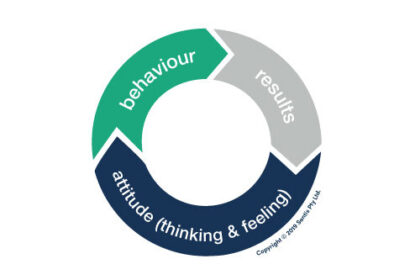What They See is What You Get
Deep underground, a team methodically chips away at the hardened rock face. Their swinging movements are seemingly haphazard, yet synchronised toward the goal of extracting hidden slivers of precious ore. The hypnotic strikes of tools are occasionally broken by the sounds of cascading rock and lumbering machinery.
One worker stands out from the rest. His work is periodically broken by shouts of frustration and exclamation. Around him, the collective mood begins to change. The team starts to feel on edge, aggressive and unfocused. Gradually the atmosphere of the work pit changes course. Nearby, a warning light flicks on; its piercing red hue blares unnoticed. Safety has been comprised.
This scenario is more common than we would like to think. Humans are inherently social beings. Over time, we have developed a keen receptivity to the emotions, attitudes and behaviours of those around us.
Understanding the impact of emotion on workplace safety
No two people are alike. We each have unique personalities, thinking patterns and ways of managing and expressing our emotions to others. Just as the miner struggled to manage his emotional state in the example above, each of us will differ in our ability to notice how we are feeling at any given moment and how we display those feelings in the workplace.
Numerous studies support the idea that emotions impact workplace health and safety. For example, emotion has been linked to problem-solving ability, motivation, distance perception and perceived effort (Clore & Huntsinger, 2007). Also, our ability to manage and process emotion during times of stress can predict safety behaviours at work. Research has found that negative affect is related to compliance with safety rules and the quality of onsite safety communication (Inness, Turner, Barling & Stride, 2010; Hahn & Murphy, 2008).
Emotion is a significant predictor of workplace safety. Emotion spreads throughout groups like pollen borne on wind. This ‘emotional contagion’ often goes unnoticed, and operates via our innate tendency to mimic the emotions of other people (Neuman & Strack, 2000). Just observing a smile or frown activates the same physical processes that would be experienced if we were feeling that emotion ourselves.
A recent study showed that cartoons were rated funnier if participants were first presented with a picture of a smiling face (Foroni & Semin, 2011). However, this effect disappeared when the experimenters prevented movement of the zygomatic major—a muscle that controls our ability to smile. So, the feelings of others first produce physical changes within observers, which are quickly followed by the matching emotional experience. Simply watching the non-verbal behaviours of others is enough to trigger a similar emotional experience, be it positive or negative.
In group settings, social rules influence thinking and behaviour. Organisations may establish such rules purposefully or they may simply evolve over time based on the characteristics of the people in the team (Kelly & Barsade, 2001). For example, the service industry typically expects workers to display a positive outlook towards customers. Acting ‘happy’ is simply part of the job, and a very powerful way of swaying customers’ purchasing decisions.
It only takes one…
Social rules may also develop based on the types of beliefs, attitudes and emotions held by particular team members. Alarmingly, research has shown that the behaviours of just one person can set these rules. In one study, 94 business undergraduates were observed as they took part in a group discussion (Barsade, 2002). Unknown to the participants, one person was actually a plant tasked by the experimenters to purposefully display negative emotions in the group setting. Overall group performance and cooperation significantly decreased as a result of this negative influence. Emotion is incredibly catching, and the symptoms of negative emotion may be more far-reaching than first thought, particularly with respect to safety.
With this evidence in mind, safety professionals, leaders and workers should be keenly aware of the adverse effects produced by negative emotions. These studies have shown that an individual’s mood is contagious, and have also confirmed that humans are hard-wired to mimic the feelings and actions of people around them.
Basically, what they see is what you get—the emotions of a single person can contaminate an entire group, resulting in impaired performance and an increased risk of injury. If left unmanaged, negative emotions can be a workplace hazard, with visible effects on team safety. So, the next time you are having an ‘off’ day, consider the very real effects that can be transmitted to your colleagues, and put strategies in place to manage your emotional experience—the safety of your team is counting on it.
References
- Clore, G. & Huntsinger, J. (2007). How emotions inform judgment and regulate thought. Trends in Cognitive Sciences, 11(9), 393 – 399.
- Inness, M., Turner, N., Barling, J. & Stride, C. (2010). Transformational leadership and employee safety behaviour: A within-person, between-jobs design. Journal of Occupational Health Psychology, 15(3), 279 – 290.
- Hahn, S. & Murphy, L. (2008). A short scale for measuring safety climate. Safety Science, 46(7), 1047 – 1066.
- Neuman, R. & Strack, F. (2000). “Mood contagion”: The automatic transfer of mood between persons. Journal of Personality and Social Psychology, 79(2), 211 – 223.
- Foroni, F. & Semin, G. (2011). When does mimicry affect evaluative judgment? Emotion, 11(3), 687 – 690.
- Kelly, J. & Barsade, S. (2001). Mood and emotions in small groups and work teams. Organizational Behavior and Human Decision Processes, 86(1), 99 – 130.
- Barsade, S. (2002). The ripple effect: Emotional contagion and its influence on group behaviour. Administrative Science Quarterly, 47, 644 – 675.




